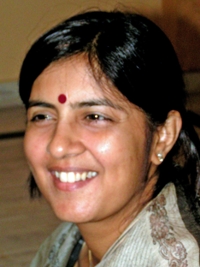Since the time that Mahavira first established the Jain sangha, Jains have for the most part remained in close-knit communities and they have chosen to limit their travel, both because their rigorous cultural and dietary habits required the support of a culturally like-minded community and because of Jain philosophies which associated the means of travel with himsa (violence). Only in the last two centuries have Jains begun to move out of India in significant numbers. In 1893, Virchand Gandhi was officially the first Jain delegate to visit the United States and represent Jainism in the first-ever Parliament of World Religions.[111]
The first wave of the Jain diaspora occurred before Independence and involved very small numbers of merchants and government officers traveling to England and to other British held territories. It was not until the late 1960s that Jains began emigrating in large numbers, still to England, which has the largest Jain population outside of India, however, now also to other places, including a significant number coming to the United States. The immigrant Jains were largely from the higher socio-economic classes and came not just out of professional requirements but also to actively pursue new global educational and business opportunities.
The Harvard University's Pluralism Project has identified 107 Jain centers in the United States including about two-dozen Jain temples.[112] With so many Jain centers, it was initially quite difficult to decide where to begin my fieldwork. Eventually I decided to begin where I study in Miami and continued my research in Los Angeles at the Jain Center of Southern California (JCSC). The JCSC was organizing a series of ten special lectures during the period of Das Lakshan[113] (the Festival of Ten Virtues) in September 2012. Taking advantage of this occasion, I set forth to find out how Jains immersed in ritualistic practices were responding to the non-religious Anuvrat Movement.
My first interview was at the residence of Professor Tara Sethia, a Jain by background, professor of History, and founder and director of the Ahimsa Center at California State Polytechnic University Pomona. She is also the author of recently published book Gandhi: Pioneer of Nonviolent Social Change.
I wondered whether she had gotten the inspiration for the Ahimsa Center from Tulsi's Anuvrat Movement, Mahapragya's Ahimsa Yatra[114] or from Gandhi's nonviolent action. When I asked her from where the inspiration came, to my great surprise she replied: "My own discipline of History, my students and my samskara."[115] Explaining further, she said "I was disappointed the way college history textbooks explain historical change by focusing largely on the role of violent revolutions, conflicts and warfare. This leads students to associate power with coercion, control and violence. The educational initiatives of the Ahimsa Center are therefore modest ways of exposing our students to the role of nonviolence as a source of and force for social change"[116]
Although Professor Sethia comes from the Jain tradition, which believes nonviolence to be the highest religious virtue, her views on ahimsa (nonviolence) were strikingly different from traditional Jainism but very close to the Anuvrat stance. She does not believe ahimsa is only a religious concept. Her vision for the Center was to delink the concept of ahimsa from any religion and make it into a subject of ethical values that students could examine critically as they would any other discipline. She reiterated with conviction: "Today nonviolence stands on its own. Religion needs nonviolence; nonviolence needs no religion. Even an atheist can be nonviolent without subscribing to any religion."[117]
Since Professor Sethia's views echoed the movement's philosophy, I asked: "Do you incorporate the Anuvrat program in your curriculum?" She lucidly replied: "No, integrating the Anuvrat program into curriculum can be perceived by some as prescriptive because of its emphasis on vows. The Center's mission has been to keep its initiatives exclusively educational in nature."[118]
Her conviction echoed the views of other respondents, suggesting the movement as a religious activity. Such an impression is despite the fact that, early in a public speech on the secularity of the movement, Tulsi said: "Anuvrat is free from any religion, and it is simply a message for ethical living. In the present times, those shrinking away from religion and fearing to be part of any sect will find Anuvrat attractive."[119]
 Shivani Bothra
Shivani Bothra
